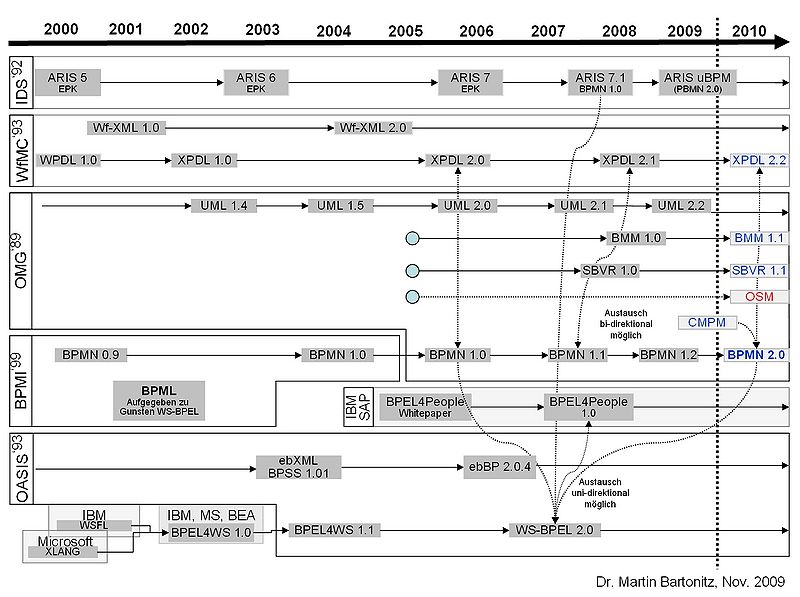Business process modeling: Difference between revisions
m (→Links) |
m (Text replacement - "<pageby nominor="false" comments="false"/>" to "<!-- <pageby nominor="false" comments="false"/> -->") |
||
| (20 intermediate revisions by the same user not shown) | |||
| Line 1: | Line 1: | ||
{{Incomplete}} | {{Incomplete}} | ||
<pageby nominor="false" comments="false"/> | <!-- <pageby nominor="false" comments="false"/> --> | ||
== Introduction == | == Introduction == | ||
| Line 55: | Line 55: | ||
; Simulator | ; Simulator | ||
: Supports what-if analysis of current or planned operations. | : Supports what-if analysis of current or planned operations. | ||
== Workflows, processes and BPM systems == | == Workflows, processes and BPM systems == | ||
| Line 106: | Line 99: | ||
See also [[e-science]], so far the only academic practice that strongly relies on IT for organizing workflows in the (narrow) sense that IT is used to connect web services and local programs to retrieve and analyze data. | See also [[e-science]], so far the only academic practice that strongly relies on IT for organizing workflows in the (narrow) sense that IT is used to connect web services and local programs to retrieve and analyze data. | ||
== In education == | |||
As far as educational technology is concerned, we could identify three main avenues for the use of business process modeling. | |||
* Use of monitoring techniques (analytics) to follow learning activities and general student progress | |||
* Use of modeling and execution technology for modelling educational scenarios, i.e. the equivalent of [[educational modeling language]]s and [[educational design language]]s as developed for instance in the domain of [[learning design]]. | |||
* Use and adaptation of BPM to run educational institutions and programs. | |||
As far as we can tell as of 2010, there a few educational projects that use BPM. [[BPMN]] and [[BPEL]] are cited in some [[educational modeling language]] papers. Karampiperis and D. Sampson (2007) examine the ability of using BPMN as notation for learning flows and present an algorithm to translate an underlying BPEL model to [[IMS Learning Design]] level A. Since IMS LD platforms do not seem to emerge (the standard was formally published in 1993 and as of 2010 there is still no usable system), we wonder whether some actors may in the future just try to use a friendly and robust [[BPMN]] 2 modeling and execution platform. Often, technology that is truly used in education, was not originally made for education ... | |||
=== BPM in workplace education === | |||
According to Miao et al. (2009) BPM may play an important role in workplace learning if combined with ''Business Process-oriented Knowledge Management'' (BPoKM). Workplace learning is developed through situated problem solving in an authentic context, i.e. concrete situations. {{quotation|The BPoKM approaches focus on aiding knowledge workers to effectively build up the knowledge and abilities that they need to fulfill tasks in their business processes (Strohmaier, 2005).}}. Since workplace learning and process-oriented knowledge management share the same objects (knowledge about real situations), Miao et al. then suggest to use the BPoKM approach to support work-based learning projects by {{quotation|1) building a business process model and knowledge repository, 2) making a WBL project plan by reusing, customizing, or creating a business process model, and 3) supporting contextualized learning through working with the project plan.}}. In the following picture, a typical learning/working configuration is shown. | |||
[[image:wbl-process-modeling-language1.png|frame|none|WBL programme model. source: [http://dspace.ou.nl/handle/1820/2218 Miao, Sloep & Koper, 2009b] ]] | |||
The interesting part of the picture is in the lower left corner, i.e. the WBL project that is part of a common WBL programme. This artifact can be both input and output for both learning and working activities. | |||
The authors then suggest several modifications in the [[IMS Learning Design]] specification. E.g. ''artifact''s are introduced as new element. {{quotation|A knowledge artifact may be an expected output of an activity such as an architectural plan or an unpredictable, externalized tacit knowledge such as a recorded reflection}} (Miao et al. 2009). They also introduce two new activity structures for specifying lower-level control flows, i.e. ''selection structure'' and '' sequence structure''. A provisional meta model was presented in a talk (Miao et al. 2009b). | |||
[[image:wbl-process-modeling-language2.png|frame|none|WBL process modeling language: Source: [http://dspace.ou.nl/handle/1820/2218 Miao, Sloep & Koper, 2009b] ]] | |||
Indeed, workplace learning may be the ideal candidate for the use BPM in education. However, any sort of [[Pedagogic_strategy#Baumgartner_-_Learning_I-II-III|learning III]] (called "mode 2" by the authors) and several learning II scenarios also need a language to deal with artifacts and the suggested modifications of IMS learning design actually should be integrated in the current version. | |||
== Standards == | == Standards == | ||
Many standards are related to BPM and workflow. The most important business process modeling standards define ''process (workflow) semantics'', i.e. [[XPDL]] and [[BPMN]], and [[BPEL]]. | Many standards are related to BPM and workflow. The most important business process modeling standards define different aspects of ''process (workflow) semantics'', i.e. [[XPDL]] and [[BPMN]], and [[BPEL]]. The following diagram also includes typical [[web service]]s stacks used to create the infrastructure for executing process definitions. | ||
[[image:WFMC-standards-classification.png|frame|none|The standards classification according to the WfMC Technical Committee - Source: [http://www.wfmc.org/reference-model.html WfMC workflow reference model] ]] | [[image:WFMC-standards-classification.png|frame|none|The standards classification according to the WfMC Technical Committee - Source: [http://www.wfmc.org/reference-model.html WfMC workflow reference model] ]] | ||
[[XPDL]] is an exchange format for process diagrames, e.g. the kind one can create with [[BPMN]]. [[BPEL]] on the other hand is an executable programming language. Also, according to [http://de.wikipedia.org/wiki/Workflow_Management_Coalition Wikipedia, Germany], [[XPDL]] is often used by workflow engines that focus on the coordination of tasks that involve humans. [[BPEL]] is mostly used as process engine for the orchestration of web services that do not involve humans. | |||
[[BPMN]] 2.0 (as of June 2010 available as draft) includes its own XML serialization format that, if we understood right, may eliminate the need for both XPDL and BPEL. In other words, BPMN 2.0 as opposed to BPMN 1.x includes support for both process design and process execution. | |||
[[image:Standards_BPM_2009_11.jpg|thumb|800px|none|Evolution of important BPM Standards. Author: [http://www.bpm-netzwerk.de/content/articles/viewArticle.do?id=d915570e265ad62201266f515ff902d0 Martin Bartonitz], Image source: [http://de.wikipedia.org/w/index.php?title=Datei:Standards_BPM_2009_11.jpg&filetimestamp=20091129195929#file Wikipedia] (German)]] | |||
== Links == | == Links == | ||
| Line 121: | Line 141: | ||
* [http://en.wikipedia.org/wiki/Enterprise_modeling Enterprise modeling], the abstract representation, description and definition of the structure, processes, information and resources of an identifiable business, government body, or other large organization. | * [http://en.wikipedia.org/wiki/Enterprise_modeling Enterprise modeling], the abstract representation, description and definition of the structure, processes, information and resources of an identifiable business, government body, or other large organization. | ||
* [http://en.wikipedia.org/wiki/Business_process_modeling Business process modeling], the activity of representing processes of an enterprise, so that the current process may be analyzed and improved. | * [http://en.wikipedia.org/wiki/Business_process_modeling Business process modeling], the activity of representing processes of an enterprise, so that the current process may be analyzed and improved. | ||
* [http://en.wikipedia.org/wiki/Enterprise_Architecture_framework Enterprise Architecture Framework]s, e.g. the [http://en.wikipedia.org/wiki/Zachman_Framework Zachman Framework] | |||
* [http://www.wfmc.org/Download-document/BPMN-2.0-Industry-Update-Presentation.html BPMN Industry update], by Rober Shapiro, 2010. | * [http://www.wfmc.org/Download-document/BPMN-2.0-Industry-Update-Presentation.html BPMN Industry update], by Rober Shapiro, 2010. | ||
* Palmer, Nathaniel (2007). [http://www.wfmc.org/index.php?option=com_docman&task=doc_download&gid=112&Itemid=72 A Survey of Business Process Initiatives], BPTends report. (overview of what users/industry were doing/planning) | * Palmer, Nathaniel (2007). [http://www.wfmc.org/index.php?option=com_docman&task=doc_download&gid=112&Itemid=72 A Survey of Business Process Initiatives], BPTends report. (overview of what users/industry were doing/planning) | ||
* [http://itredux.com/2008/10/24/why-all-this-matters/ Why All This Matters], Oct. 2008 by Ismael Ghalimi (co-founder Intalio). | |||
; Players that define standards | ; Players that define standards | ||
| Line 134: | Line 157: | ||
; Tools and standards | ; Tools and standards | ||
* See [[BPMN]] (Business Process Modeling Notation), [[BPEL]] (Business Process Execution Language), [[XPDL]] (XML Process Definition Language) | * See [[BPMN]] (Business Process Modeling Notation), [[BPEL]] (Business Process Execution Language), [[XPDL]] (XML Process Definition Language) | ||
; Proprietary solutions | |||
* [http://www.metasonic.de/en/metasonic-suite S-BPM] (Metasonic) | |||
== References == | == References == | ||
* Debevoise, Tom (2007). Business Process Management with a Business Rules Approach: Implementing The Service Oriented Architecture, BookSurge Publishing, ISBN 1419673688 (an easy high level overview book according to reviewers) | |||
* Karampiperis P. and D. Sampson, "Towards a Common Graphical Language for Learning Flows: Transforming BPEL to IMS Learning Design Level A Representations", in J. M. Spector, D. Sampson, T. Okamoto, Kinshuk, S. A. Cerri, M. Ueno and A. Kashihara (Eds). Proc. of the 7th IEEE International Conference on Advanced Learning Technologies (ICALT 2007), ISBN:9780769529165, pp. 798-800, Niigata, Japan, IEEE Computer Society, July 2007 [http://dspace.ou.nl/handle/1820/958 Preprint] | |||
* Hollingsworth, David (1995), The Workflow Reference Model, Workflow Management Coalition, Document Number TC00-1003, [http://www.wfmc.org/reference-model.html Abstract/download]. | * Hollingsworth, David (1995), The Workflow Reference Model, Workflow Management Coalition, Document Number TC00-1003, [http://www.wfmc.org/reference-model.html Abstract/download]. | ||
* Jeston, John, Business Process Management (2008), Second Edition: Practical Guidelines to Successful Implementations, Butterworth-Heinemann; 2 edition, ISBN 0750686561 (step by step guide on how to implement a BPM project). | |||
* Miao, Yongwu; Peter Sloep & Rob Koper (2009). Facilitating Work Based Learning Projects: A Business Process Oriented Knowledge Management Approach, Paper presented at the 'Open workshop of TENCompetence - Rethinking Learning and Employment at a Time of Economic Uncertainty-event'. November, 19-20, 2009, Manchester, UK: TENCompetence. [http://dspace.ou.nl/handle/1820/2108 Abstract/PDF] | |||
* Miao, Yongwu; Peter Sloep & Rob Koper (2009b). Facilitating Work Based Learning Projects: A Business Process Oriented Knowledge Management Approach, Paper presented at the 'Open workshop of TENCompetence - Rethinking Learning and Employment at a Time of Economic Uncertainty-event'. November, 19-20, 2009, Manchester, UK: TENCompetence. [http://dspace.ou.nl/handle/1820/2218 Slides Abstract/PDF] | |||
* zur Muehlen, M.; Shapiro, R.: Business Process Analytics. In: Rosemann, M.; vom Brocke, J.: Handbook on Business Process Management, Vol. 2, Springer Verlag, Berlin et al. 2009. [http://processanalytica.com/zur_shapiro.pdf PDF preprint] | * zur Muehlen, M.; Shapiro, R.: Business Process Analytics. In: Rosemann, M.; vom Brocke, J.: Handbook on Business Process Management, Vol. 2, Springer Verlag, Berlin et al. 2009. [http://processanalytica.com/zur_shapiro.pdf PDF preprint] | ||
* zur Muehlen, M. (2004) Workflow-based Process Controlling. Foundation, Design, and Implementation of Workflow-driven Process Information Systems. Berlin: Logos. | * zur Muehlen, M. (2004) Workflow-based Process Controlling. Foundation, Design, and Implementation of Workflow-driven Process Information Systems. Berlin: Logos. (A kind of textbook, uses UML) | ||
* Sharp, A. and Patrick McDermott (2009). Workflow modeling : tools for process improvement and applications development (2nd ed.). Boston: Artech House. | |||
* Shapiro, Robert (2008). Integration of Workforce Management with a Business Process Management Suit ''in'' ''BPM and Workflow Handbook'', Future Strategies Inc. | * Shapiro, Robert (2008). Integration of Workforce Management with a Business Process Management Suit ''in'' ''BPM and Workflow Handbook'', Future Strategies Inc. | ||
| Line 148: | Line 186: | ||
* Shapiro, Robert M. (2006). XPDL 2.0: Integrating Process Interchange and BPMN, in Fischer, Layna (ed.), ''2006 BPM and Workflow Handbook'', Future Strategies Inc. [http://www.futstrat.com/books/handbook06.php PDF reprint] | * Shapiro, Robert M. (2006). XPDL 2.0: Integrating Process Interchange and BPMN, in Fischer, Layna (ed.), ''2006 BPM and Workflow Handbook'', Future Strategies Inc. [http://www.futstrat.com/books/handbook06.php PDF reprint] | ||
* Strohmaier, M. B. (2005). B-KIDE: A Framework and a Tool for Business Process Oriented Knowledge Infrastructure Development, PhD Thesis, Publisher: Shaker Verlag. | |||
* Taylor (2010), Intelligent, Automated Processes: Embedding Analytics in Decisions, ''in'' Fischer, Layna (ed.) ''2010 BPM and Workflow Handbook, Spotlight on Business Intelligence'', FutStrat. [http://www.futstrat.com/books/book_images/2010_BPM_Handbook_Free_Chapters.pdf PDF reprint] | * Taylor (2010), Intelligent, Automated Processes: Embedding Analytics in Decisions, ''in'' Fischer, Layna (ed.) ''2010 BPM and Workflow Handbook, Spotlight on Business Intelligence'', FutStrat. [http://www.futstrat.com/books/book_images/2010_BPM_Handbook_Free_Chapters.pdf PDF reprint] | ||
* Swenson Keith (2007). The Business Value of Workflow and BPM, in Fischer, Layna (ed.) ''2007 BPM & Workflow Handbook'' FutStrat. [http://www.futstrat.com/books/downloads/Swenson_Business_value_of_BPM.pdf PDF reprint] | * Swenson Keith (2007). The Business Value of Workflow and BPM, in Fischer, Layna (ed.) ''2007 BPM & Workflow Handbook'' FutStrat. [http://www.futstrat.com/books/downloads/Swenson_Business_value_of_BPM.pdf PDF reprint] | ||
* Weske, M.: Business Process Management (2007). Concepts, Languages, Architectures. Springer-Verlag Berlin Heidelberg, ISBN: 978-3-540-73521-2. See the [http://www.bpmn-book.com/ book's website] | |||
[[Category: workflow]] | [[Category: workflow]] | ||
[[Category: Organization and management]] | [[Category: Organization and management]] | ||
[[Category: Affect and motivation]] | [[Category: Affect and motivation]] | ||
[[Category: Educational modeling languages]] | |||
[[Category:Analytics]] | |||
[[Category:BPMN]] | |||
Latest revision as of 17:42, 22 August 2016
Introduction
Business process modeling (BPM) refers to the modeling of activities performed within an organization. Typically, an activity is viewed as a workflow or process composed of events, activities, gateways and (sometimes) other elements. More precisely a “business process [can be defined] as a collection of related, structured activities or tasks that produce a specific service or product (serve a particular goal) for a particular customer or customers” (Wikipedia, retrieved June 23 2010). However, business process modeling is also used in other areas, e.g. in government organization such as the US department of defense or for defining research workflows in e-science environments.
“Business process modeling (BPM) in systems engineering and software engineering is the activity of representing processes of an enterprise, so that the current process may be analyzed and improved” (Wikipedia, retrieved June 23 2010). In other words, BPM is often related to (business) reengineering and even more substantial change management.
We can distinguish between three main types of processes and we also attempt to relate these to educational examples.
- Management processes, e.g. organizational governance, conducting a large research project or a training program.
- Operational processes, e.g. plan and conduct a research project, define and enact a pedagogical scenario.
- Supporting processes, e.g. technical support (network, file servers, e-mail, etc.) or human resource management (authors, experts, tutors, etc.)
See also: enterprise architecture framework, workflow, e-science (BPM applied to research workflows), BPMN (a typical notation language for process modeling), and BPEL and XPDL (two XML modeling languages).
Process management systems
BPM also may refer to business process management for which business process modeling can be a tool. Business process management is strongly related to the idea of improving an organization's performance.
According to Shapiro and Genrich, an improvement (re-engineering) process can be characterized as the following set of steps:
- Analyze the historical (or simulation) data to determine where improvements are needed. If the evaluation is satisfactory, stop.
- From the data, come up with an idea for improvement.
- Create a simulation scenario incorporating that idea and run a simulation.
- Evaluate the results to determine whether it has resulted in improvement and repeat the cycle.
Business process activities can be implemented and coordinated as a combination of web services orchestration and choreography. Orchestration refers to a multi-step process model that leads to a single end-point (e.g. an offer). It describes how web services interact with each other in terms of a "executable business logic" at the message level. Choreography defines more loose collaborative behaviors between various participants. Choreographies can define rules of interaction and agreements between independent participants. In more technical terms, messages are exchanged between business process endpoints, i.e. choreographies imply that participants implement orchestrations to deal with these exchanges.
Business analytics
“Business Process Management Systems are a rich source of events that document the execution of processes and activities within these systems. Business Process Analytics is the family of methods and tools that can be applied to these event streams in order to support decision-making in organizations. The analysis of process events can focus on the behavior of completed processes, evaluate currently running process instances, or focus on predicting the behavior of process instances in the future.” (Shapiro and Muehlen, 2008:Abstract, retrieved 10:33, 25 June 2010 (UTC)).
Shapiro and Muehlen (2009) identify two strategic perspectives for business analytics: (1) Performance: improve reaction time and evaluation of decisions and (2) Compliance: adherence of process execution with rules and insurance of contractual obligations. In an temporal perspective: “To evaluate what has happened in the past, to understand what is happening at the moment, or to develop an understanding of what might happen in the future.” (p.2). Various related analytical perspectives are known as Process Controlling, Process Mining, Business Activity Monitoring, Process Intelligence, etc.
Taylor (2010) identifies four different kinds of analytical insight: business intelligence (what is happening, who are my customers), descriptive analysis (what is the profile of my best customers), predictive analysis (how will X behave in the future) and optimization simulation (how can I extract maximum value from an investment).
List of BPMS components
While educational technologists are probably most interested by workflow management systems that are more exhaustively described below, there exist a variety of tools that can be subsumed under the label of Business process management systems (BPMS).
Shapiro and Genrich identify the following elements that may be part of a complete BPMS solution:
- Analytics
- Storage and processing of operations data to provide useful business information.
- Business Activity Monitoring (BAM)
- Real time depiction of Key Performance Indicators (KPIs) and generation of alerts etc.
- Data Miner
- Statistical processing of business information to extrDocument Number TC00-1003act patterns, detect trends and make predictions.
- Event Stream
- Flow of information packets about meaningful state changes. The log events generated by currently running processes are an example.
- Execution Engine
- Any business process enactment service, including workflow engines, BPEL executor, Enterprise resource planning (ERP) system etc.
- Optimizer
- A software tool that utilizes the Data Miner and/or Simulator to make recommendations for changes to business operations.
- Rules Engine
- A software system that helps manage and automate business rules. Used to detect interesting business situations automatically.
- Simulator
- Supports what-if analysis of current or planned operations.
Workflows, processes and BPM systems
Business Processes (as opposed to manufacturing processes for example) “set of one or more linked procedures or activities which collectively realize a business objective or policy goal, normally within the context of an organizational structure defining functional roles and relationships.” (Swenson, 2007. In more simple terms, a business process model defines workflows in terms of activities (steps) and transitions (transitions between steps).
“Workflow is concerned with the automation of procedures where documents, information or tasks are passed between participants according to a defined set of rules to achieve, or contribute to, an overall business goal. Whilst workflow may be manually organised, in practice most workflow is normally organised within the context of an IT system to provide computerised support for the procedural automation. [...] Workflow is often associated with Business Process Re-engineering, which is concerned with the assessment, analysis, modelling, definition and subsequent operational implementation of the core business processes of an organisation (or other business entity). [...] A Workflow Management System is one which provides procedural automation of a business process by management of the sequence of work activities and the invocation of appropriate human and/or IT resources associated with the various activity steps.” (The Workflow Reference Model, 1995:6])
The WfMC workflow reference model characterizes a workflow mangement system (1995:6-7) (WFM) system as providing support in three functional areas:
- the Build-time functions, concerned with defining, and possibly modelling, the workflow process and its constituent activities
- the Run-time control functions concerned with managing the workflow processes in an operational environment and sequencing the various activities to be handled as part of each process
- the Run-time interactions with human users and IT application tools for processing the various activity
The following figure illustrates the basic characteristics of WFM systems and the relationships between these main functions:
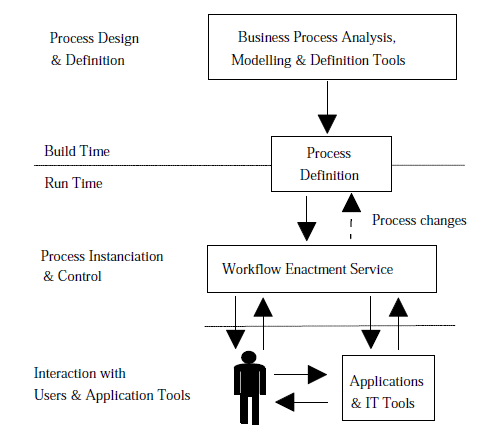
The WfMC workflow reference model also includes a a generic workflow product structure model that includes three components:
- software components which provide support for various functions within the workflow system (shown in dark fill)
- various types of system definition and control data (shown unfilled) which are used by one or more software components
- applications and application databases (shown in light fill) which are not part of the workflow product, but which may be invoked by it as part of the total workflow system
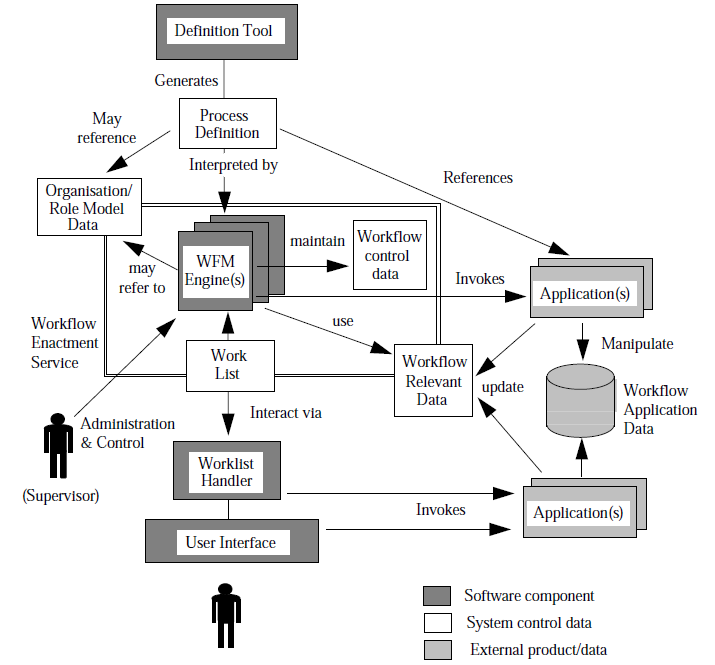
In a different, more operational view, the 1995 WfMC workflow reference model (1995:21-25) defines the following architecture. At the heart we find:
- A Workflow Enactment Service: A software service that may consist of one or more workflow engines in order to create, manage and execute workflow instances. Applications may interface to this service via the workflow application programming interface (WAPI).
- One or more workflow engines: A software service or "engine" that provides the run time execution environment for a workflow instance.
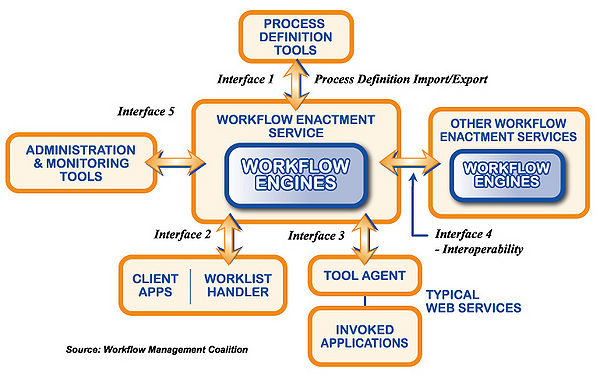
The workflow enactement service then can interact with other software throug five types of interfaces defined as follows:
- Interface 1: exchange of process definition data between BPR tools, workflow systems and process definition repositories;
- Interface 2: client application integration with different workflow systems, defined as a series of workflow APIs;
- Interface 3: a common framework for 3rd parties to integrate other industry applications & services;
- Interface 4: interoperability with other enactment systems;
- Interface 5: audit and administration of workflow cases across systems;
A more recent informal document, The workflow reference model - 10 years on - presents a BPM component modeling terms of a development/execution view. The top half defines the definition process of a business model and the lower half its enactment.
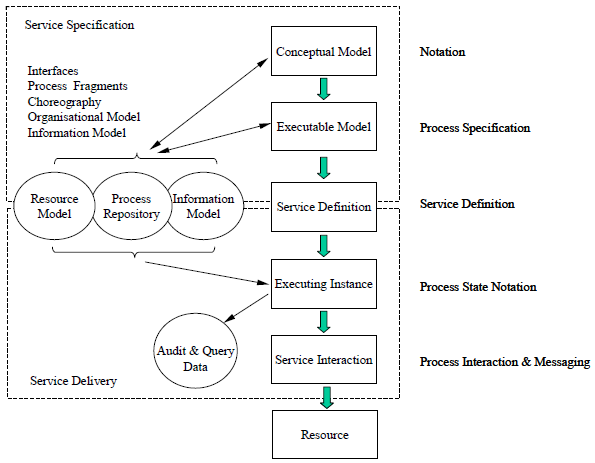
Finally, the model (p30) also includes an interesting process definition meta-model of the kind that could be useful for the implementation of learning design engines.

See also e-science, so far the only academic practice that strongly relies on IT for organizing workflows in the (narrow) sense that IT is used to connect web services and local programs to retrieve and analyze data.
In education
As far as educational technology is concerned, we could identify three main avenues for the use of business process modeling.
- Use of monitoring techniques (analytics) to follow learning activities and general student progress
- Use of modeling and execution technology for modelling educational scenarios, i.e. the equivalent of educational modeling languages and educational design languages as developed for instance in the domain of learning design.
- Use and adaptation of BPM to run educational institutions and programs.
As far as we can tell as of 2010, there a few educational projects that use BPM. BPMN and BPEL are cited in some educational modeling language papers. Karampiperis and D. Sampson (2007) examine the ability of using BPMN as notation for learning flows and present an algorithm to translate an underlying BPEL model to IMS Learning Design level A. Since IMS LD platforms do not seem to emerge (the standard was formally published in 1993 and as of 2010 there is still no usable system), we wonder whether some actors may in the future just try to use a friendly and robust BPMN 2 modeling and execution platform. Often, technology that is truly used in education, was not originally made for education ...
BPM in workplace education
According to Miao et al. (2009) BPM may play an important role in workplace learning if combined with Business Process-oriented Knowledge Management (BPoKM). Workplace learning is developed through situated problem solving in an authentic context, i.e. concrete situations. “The BPoKM approaches focus on aiding knowledge workers to effectively build up the knowledge and abilities that they need to fulfill tasks in their business processes (Strohmaier, 2005).”. Since workplace learning and process-oriented knowledge management share the same objects (knowledge about real situations), Miao et al. then suggest to use the BPoKM approach to support work-based learning projects by “1) building a business process model and knowledge repository, 2) making a WBL project plan by reusing, customizing, or creating a business process model, and 3) supporting contextualized learning through working with the project plan.”. In the following picture, a typical learning/working configuration is shown.
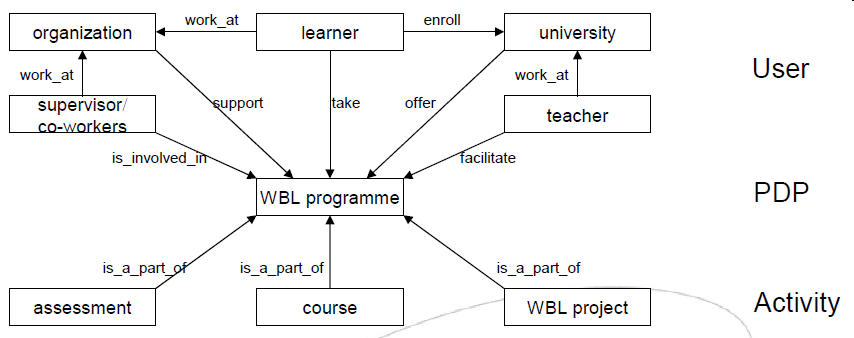
The interesting part of the picture is in the lower left corner, i.e. the WBL project that is part of a common WBL programme. This artifact can be both input and output for both learning and working activities.
The authors then suggest several modifications in the IMS Learning Design specification. E.g. artifacts are introduced as new element. “A knowledge artifact may be an expected output of an activity such as an architectural plan or an unpredictable, externalized tacit knowledge such as a recorded reflection” (Miao et al. 2009). They also introduce two new activity structures for specifying lower-level control flows, i.e. selection structure and sequence structure. A provisional meta model was presented in a talk (Miao et al. 2009b).

Indeed, workplace learning may be the ideal candidate for the use BPM in education. However, any sort of learning III (called "mode 2" by the authors) and several learning II scenarios also need a language to deal with artifacts and the suggested modifications of IMS learning design actually should be integrated in the current version.
Standards
Many standards are related to BPM and workflow. The most important business process modeling standards define different aspects of process (workflow) semantics, i.e. XPDL and BPMN, and BPEL. The following diagram also includes typical web services stacks used to create the infrastructure for executing process definitions.
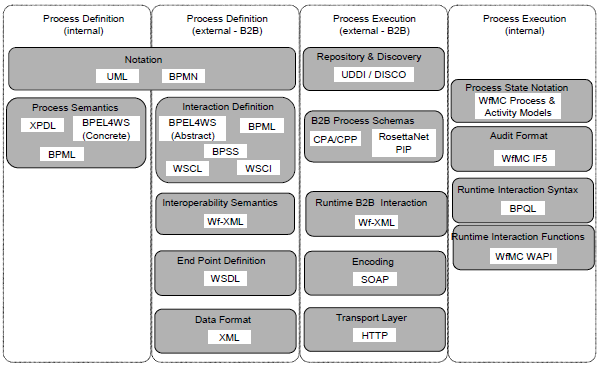
XPDL is an exchange format for process diagrames, e.g. the kind one can create with BPMN. BPEL on the other hand is an executable programming language. Also, according to Wikipedia, Germany, XPDL is often used by workflow engines that focus on the coordination of tasks that involve humans. BPEL is mostly used as process engine for the orchestration of web services that do not involve humans.
BPMN 2.0 (as of June 2010 available as draft) includes its own XML serialization format that, if we understood right, may eliminate the need for both XPDL and BPEL. In other words, BPMN 2.0 as opposed to BPMN 1.x includes support for both process design and process execution.
Links
- Overviews
- Enterprise modeling, the abstract representation, description and definition of the structure, processes, information and resources of an identifiable business, government body, or other large organization.
- Business process modeling, the activity of representing processes of an enterprise, so that the current process may be analyzed and improved.
- Enterprise Architecture Frameworks, e.g. the Zachman Framework
- BPMN Industry update, by Rober Shapiro, 2010.
- Palmer, Nathaniel (2007). A Survey of Business Process Initiatives, BPTends report. (overview of what users/industry were doing/planning)
- Why All This Matters, Oct. 2008 by Ismael Ghalimi (co-founder Intalio).
- Players that define standards
- WfMC (the Workflow Management Coalition), Founded in 1993, the Workflow Management Coalition (WfMC) is a global organization of adopters, developers, consultants, analysts, as well as university and research groups engaged in workflow and BPM. The WfMC creates and contributes to process related standards, educates the market on related issues, and is the only standards organization that concentrates purely on process.
- OMG (the Object Management Group), an international, open membership, not-for-profit computer industry consortium since 1989. OMG’s modeling standards, including the Unified Modeling Language (UML), Model Driven Architecture (MDA). OMG works in liaison with other organizations such as WfMC and also is an ISO submitter.
- BPMI, the Business Process Management Initiative, merged in 2005 their Business Process Management activities with OMG.
- Other
- 2010 BPM & Workflow Handbook (4 free chapters for download).
- Tools and standards
- See BPMN (Business Process Modeling Notation), BPEL (Business Process Execution Language), XPDL (XML Process Definition Language)
- Proprietary solutions
- S-BPM (Metasonic)
References
- Debevoise, Tom (2007). Business Process Management with a Business Rules Approach: Implementing The Service Oriented Architecture, BookSurge Publishing, ISBN 1419673688 (an easy high level overview book according to reviewers)
- Karampiperis P. and D. Sampson, "Towards a Common Graphical Language for Learning Flows: Transforming BPEL to IMS Learning Design Level A Representations", in J. M. Spector, D. Sampson, T. Okamoto, Kinshuk, S. A. Cerri, M. Ueno and A. Kashihara (Eds). Proc. of the 7th IEEE International Conference on Advanced Learning Technologies (ICALT 2007), ISBN:9780769529165, pp. 798-800, Niigata, Japan, IEEE Computer Society, July 2007 Preprint
- Hollingsworth, David (1995), The Workflow Reference Model, Workflow Management Coalition, Document Number TC00-1003, Abstract/download.
- Jeston, John, Business Process Management (2008), Second Edition: Practical Guidelines to Successful Implementations, Butterworth-Heinemann; 2 edition, ISBN 0750686561 (step by step guide on how to implement a BPM project).
- Miao, Yongwu; Peter Sloep & Rob Koper (2009). Facilitating Work Based Learning Projects: A Business Process Oriented Knowledge Management Approach, Paper presented at the 'Open workshop of TENCompetence - Rethinking Learning and Employment at a Time of Economic Uncertainty-event'. November, 19-20, 2009, Manchester, UK: TENCompetence. Abstract/PDF
- Miao, Yongwu; Peter Sloep & Rob Koper (2009b). Facilitating Work Based Learning Projects: A Business Process Oriented Knowledge Management Approach, Paper presented at the 'Open workshop of TENCompetence - Rethinking Learning and Employment at a Time of Economic Uncertainty-event'. November, 19-20, 2009, Manchester, UK: TENCompetence. Slides Abstract/PDF
- zur Muehlen, M.; Shapiro, R.: Business Process Analytics. In: Rosemann, M.; vom Brocke, J.: Handbook on Business Process Management, Vol. 2, Springer Verlag, Berlin et al. 2009. PDF preprint
- zur Muehlen, M. (2004) Workflow-based Process Controlling. Foundation, Design, and Implementation of Workflow-driven Process Information Systems. Berlin: Logos. (A kind of textbook, uses UML)
- Sharp, A. and Patrick McDermott (2009). Workflow modeling : tools for process improvement and applications development (2nd ed.). Boston: Artech House.
- Shapiro, Robert (2008). Integration of Workforce Management with a Business Process Management Suit in BPM and Workflow Handbook, Future Strategies Inc.
- Shapiro, Robert M. and Hartmann Genrich, The Auto Optimizer, Global 360, United States, PDF
- Shapiro, Robert M. (2006). XPDL 2.0: Integrating Process Interchange and BPMN, in Fischer, Layna (ed.), 2006 BPM and Workflow Handbook, Future Strategies Inc. PDF reprint
- Strohmaier, M. B. (2005). B-KIDE: A Framework and a Tool for Business Process Oriented Knowledge Infrastructure Development, PhD Thesis, Publisher: Shaker Verlag.
- Taylor (2010), Intelligent, Automated Processes: Embedding Analytics in Decisions, in Fischer, Layna (ed.) 2010 BPM and Workflow Handbook, Spotlight on Business Intelligence, FutStrat. PDF reprint
- Swenson Keith (2007). The Business Value of Workflow and BPM, in Fischer, Layna (ed.) 2007 BPM & Workflow Handbook FutStrat. PDF reprint
- Weske, M.: Business Process Management (2007). Concepts, Languages, Architectures. Springer-Verlag Berlin Heidelberg, ISBN: 978-3-540-73521-2. See the book's website
